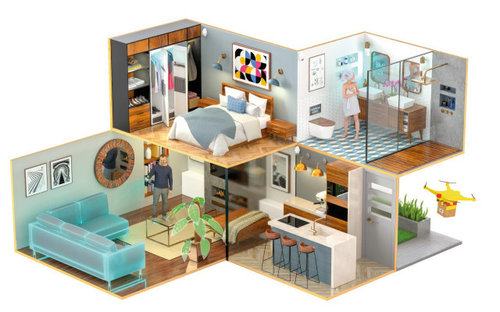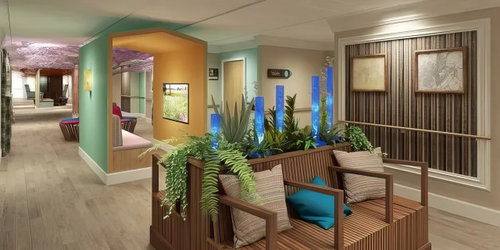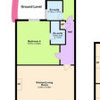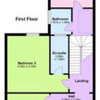Here's What the Care Homes of the Future Should Look Like
The landscape of care homes is ever-changing, and with the aging population growing, the need for more advanced and human-centric care homes is paramount. Here's what the care homes of the future should look like, focusing on the integration of technology, personalized care, community integration, and specialized training such as dementia training for carers in the UK.

Future of Care Homes: An Overview
Designing for Dignity and Comfort
Innovative Architecture
Future care homes must be designed with the residents' comfort and dignity in mind. This includes spacious rooms, natural lighting, easy access to outdoor spaces, and architectural features that promote a sense of community. The design must be aesthetically pleasing and functional, allowing residents to move freely and engage in daily activities without hindrance.
Home-like Environment
Creating a home-like environment with personalized touches helps residents feel more at ease and promotes a sense of belonging. This includes the use of familiar furnishings, decor that reflects residents' tastes, and communal spaces that encourage social interaction. The goal is to create a setting that feels less like an institution and more like a home.
Accessibility
Ensuring that the facility is accessible to all residents, regardless of mobility challenges, is crucial. This includes ramps, elevators, and other assistive devices. Accessibility goes beyond physical structures; it also involves creating an environment where residents feel empowered to participate in activities and make choices about their care.

Technology Integration
Smart Technology
The integration of smart technology can enhance the quality of care by monitoring health, managing medication, and providing entertainment. Smart devices can track vital signs, remind residents to take medications, and allow family members to stay connected through video calls. The use of technology should be balanced with personal interaction to ensure that residents do not feel isolated or overly monitored.
Telemedicine
Telemedicine allows for remote consultations with healthcare professionals, ensuring timely medical care. This can be particularly beneficial in rural areas where access to specialized medical care may be limited. Telemedicine also allows for continuous monitoring and early intervention, potentially preventing minor issues from becoming major problems.
Virtual Reality
Virtual reality (VR) can be used for therapeutic purposes, such as helping residents with dementia reconnect with past experiences or providing physical therapy in a controlled virtual environment. VR can also offer recreational opportunities, allowing residents to "travel" to exotic locations or engage in activities that may be physically challenging in real life.

Personalized Care Plans
Individual Assessment
Each resident's needs and preferences must be assessed to create a personalized care plan. This involves a comprehensive evaluation of medical history, physical abilities, cognitive function, emotional needs, and personal preferences. The care plan should be a living document, regularly updated to reflect changes in the resident's condition or desires.
Ongoing Monitoring
Regular monitoring and adjustments to the care plan ensure that the resident's needs are continually met. This involves ongoing communication between staff, residents, and family members, as well as regular assessments by medical professionals. The goal is to provide care that is responsive and adaptive, rather than static and rigid.
Family Involvement
Including family members in the care planning process fosters a more holistic approach to care. Family members often have insights into the resident's history, preferences, and personality that can inform the care plan. Regular communication with family members also helps them feel involved and reassured about the care their loved one is receiving.

Community Integration
Community Involvement
Encouraging community involvement helps residents stay connected to society and enhances their quality of life. This can include inviting community groups to perform or lead activities, organizing outings to local events, or partnering with schools for intergenerational programs. Community involvement fosters a sense of belonging and helps residents maintain a connection to the world outside the care home.
Local Partnerships
Collaborating with local businesses and organizations can provide residents with more opportunities for social engagement. This might include arranging for local chefs to conduct cooking classes, partnering with art galleries for exhibitions, or collaborating with universities for educational programs. Local partnerships enrich the lives of residents and strengthen the connection between the care home and the community.
Intergenerational Programs
Programs that bring together different generations foster understanding and enrich the lives of both young and old. This can include mentoring programs, joint art projects, or shared gardening activities. Intergenerational programs break down age barriers and create meaningful connections that benefit everyone involved.

Specialized Training
Dementia Training
Dementia training for carers in the UK is essential to ensure that staff are equipped to provide specialized care for residents with dementia. This training should cover the medical aspects of dementia, as well as strategies for communication, behavior management, and creating a supportive environment. Dementia care requires empathy, patience, and a deep understanding of the unique challenges faced by individuals with this condition.
Cultural Sensitivity Training
Training staff to be culturally sensitive ensures that they can cater to the diverse needs of residents. This includes understanding different cultural norms, beliefs, and practices related to health, diet, and social interaction. Cultural sensitivity promotes respect and inclusivity, ensuring that all residents feel valued and understood.
Ongoing Professional Development
Regular training and professional development keep staff up-to-date with the latest best practices in care. This includes ongoing education in medical care, therapeutic techniques, communication skills, and ethical considerations. Investing in staff development not only improves the quality of care but also promotes staff retention and job satisfaction.

Importance of Mental Health Care
Mental Health Support
Providing mental health support is crucial for the overall well-being of residents. This includes access to mental health professionals, support groups, and therapeutic activities. Mental health care should be integrated into the overall care plan, recognizing that emotional well-being is as important as physical health.
Therapeutic Activities
Engaging residents in therapeutic activities such as art therapy, music therapy, or mindfulness practices can enhance their mental well-being. These activities provide creative outlets for expression, opportunities for social interaction, and strategies for managing stress and anxiety.
Counseling Services
Offering counseling services ensures that residents have access to professional mental health care when needed. This can include individual counseling, family therapy, or specialized support for issues such as grief or depression. Counseling services provide a safe space for residents to explore their feelings and receive expert guidance.
Environmental Sustainability
Eco-Friendly Design
Implementing eco-friendly design principles reduces the environmental impact of care homes. This includes energy-efficient lighting and appliances, water-saving fixtures, and the use of sustainable building materials. Eco-friendly design not only benefits the environment but can also create a more pleasant and healthy living space.

Sustainable Practices
Adopting sustainable practices such as recycling, composting, and energy conservation demonstrates a commitment to environmental stewardship. These practices can be integrated into daily operations and involve residents in meaningful ways. For example, residents can participate in recycling programs or help maintain a composting system for garden waste.
Gardening Programs
Involving residents in gardening not only provides therapeutic benefits but also promotes sustainability. Gardening programs can include growing vegetables and herbs for use in meals, maintaining flower gardens for beauty and enjoyment, or creating wildlife habitats to support local ecosystems. Gardening connects residents with nature and fosters a sense of accomplishment and purpose.
Government Regulations and Support
Compliance with Regulations
Care homes must comply with government regulations to ensure the safety and well-being of residents. This includes regulations related to building codes, staffing levels, medical care, and residents' rights. Compliance requires ongoing monitoring, documentation, and a commitment to maintaining high standards of care.
Government Funding
Adequate government funding is essential to provide quality care and maintain the facility. Funding supports staffing, medical services, recreational programs, and facility maintenance. Advocacy for appropriate funding is an ongoing responsibility for care home administrators and requires collaboration with government agencies and policymakers.

Policy Advocacy
Advocating for policies that support the needs of care home residents ensures that their voices are heard at the governmental level. This includes advocating for funding, regulations that protect residents' rights, and policies that promote innovation and quality in care home services. Policy advocacy requires collaboration with other organizations, engagement with policymakers, and a clear understanding of the political landscape.
Collaboration with Healthcare Providers
Integrated Healthcare
Collaborating with healthcare providers ensures that residents receive comprehensive medical care. This includes coordination with primary care physicians, specialists, pharmacists, and other healthcare professionals. Integrated healthcare promotes continuity of care and ensures that residents' medical needs are met in a timely and coordinated manner.
Specialized Medical Services
Access to specialized medical services such as physiotherapy, occupational therapy, or speech therapy enhances the quality of care. These services provide targeted support for specific medical conditions and can significantly improve residents' quality of life. Collaboration with specialized providers ensures that residents receive expert care tailored to their individual needs.
Emergency Preparedness
Having protocols in place for medical emergencies ensures timely and appropriate care. This includes training staff in emergency procedures, having necessary medical equipment on hand, and establishing relationships with local emergency services. Emergency preparedness provides reassurance to residents and their families and minimizes risks in critical situations.
Family Involvement
Family Communication
Regular communication with family members keeps them informed and involved in their loved one's care. This can include regular updates, family meetings, and opportunities for family members to participate in care planning. Open and transparent communication builds trust and helps family members feel connected to the care home community.
Family Support Programs
Offering support programs for families helps them cope with the challenges of having a loved one in a care home. This can include support groups, educational workshops, or counseling services. Family support programs recognize that the well-being of family members is an integral part of the overall care process.
Visiting Policies
Flexible visiting policies encourage family interaction and strengthen the bond between residents and their families. This includes accommodating visits outside of regular visiting hours, providing comfortable spaces for family gatherings, and supporting overnight visits when appropriate. Visiting policies should balance the needs of residents with the operational considerations of the care home.
Cultural Sensitivity
Cultural Awareness
Understanding and respecting the cultural backgrounds of residents is essential for providing personalized care. This includes recognizing cultural traditions, dietary preferences, language needs, and religious practices. Cultural awareness fosters a sense of respect and inclusivity, ensuring that all residents feel valued and understood.
Culturally Appropriate Activities
Offering activities that reflect the cultural heritage of residents enhances their sense of identity and belonging. This can include celebrating cultural holidays, cooking traditional meals, or engaging in cultural arts and crafts. Culturally appropriate activities provide opportunities for residents to connect with their heritage and share it with others.
Diverse Staff
Hiring staff from diverse backgrounds fosters a more inclusive environment. Diversity in staffing reflects the diversity of residents and provides opportunities for cross-cultural understanding and connection. A diverse staff also brings a broader range of skills, perspectives, and approaches to care.

Accessibility and Mobility
Accessible Facilities
Ensuring that all areas of the care home are accessible to residents with mobility challenges is crucial. This includes not only physical structures such as ramps and elevators but also programmatic accessibility, ensuring that all activities and services are available to all residents. Accessibility promotes independence and empowerment, allowing residents to fully participate in the life of the care home.
Mobility Aids
Providing mobility aids such as wheelchairs or walkers enhances the independence of residents. Mobility aids should be personalized to the individual's needs and preferences, and staff should be trained in their proper use. Mobility aids support residents in daily activities and social interactions, enhancing their quality of life.
Transportation Services
Offering transportation services facilitates residents' access to external activities and appointments. This includes medical appointments, shopping trips, or cultural outings. Transportation services should be accessible, reliable, and tailored to the individual needs of residents, allowing them to maintain connections to the broader community.
Safety Measures
Safety Protocols
Implementing safety protocols minimizes risks and ensures the well-being of residents. This includes protocols for medication management, infection control, fall prevention, and emergency evacuation. Safety protocols require ongoing training, monitoring, and a culture of safety within the care home.
Emergency Preparedness
Having a comprehensive emergency preparedness plan ensures that staff are equipped to handle unexpected situations. This includes plans for natural disasters, power outages, medical emergencies, or other unforeseen events. Emergency preparedness requires regular drills, clear communication, and collaboration with local emergency services.
Security Measures
Implementing security measures such as surveillance cameras, secure entrances, and visitor screening protects residents and staff. Security measures should be balanced with the need for a welcoming and open environment, recognizing that safety and community are both essential aspects of care home life.
Nutrition and Diet Planning
Personalized Meal Plans
Creating personalized meal plans based on residents' dietary needs and preferences ensures proper nutrition. This includes accommodating special diets, allergies, or cultural preferences. Personalized meal plans promote enjoyment of meals and support overall health and well-being.
Dietary Consultations
Collaborating with dietitians or nutritionists ensures that residents receive balanced and nutritious meals. Dietary consultations provide expert guidance on nutritional needs, taking into account medical conditions, medications, and individual preferences. Regular consultations ensure that meal plans are updated as residents' needs change.

Cultural Considerations
Offering culturally appropriate meals enhances residents' dining experience. This includes recognizing cultural traditions related to food preparation, mealtime rituals, and dietary restrictions. Cultural considerations in meal planning create a sense of familiarity and comfort and allow residents to enjoy the foods they love.
Recreational Activities
Diverse Activities
Offering a diverse range of activities caters to the varied interests of residents. This includes physical activities, creative arts, intellectual pursuits, and social gatherings. A diverse activity program ensures that all residents have opportunities to engage in activities that they enjoy and that challenge and stimulate them.
Therapeutic Recreation
Engaging residents in therapeutic recreation enhances their physical and mental well-being. Therapeutic recreation includes activities that are specifically designed to address individual needs, such as physical therapy exercises, memory games for cognitive stimulation, or relaxation techniques for stress reduction. Therapeutic recreation supports overall health and enhances the quality of life.

Conclusion
The future of care homes is a dynamic and multifaceted landscape that requires a holistic approach. Here's what the care homes of the future should look like: a place where residents feel at home, cared for, respected, and engaged. The integration of innovative design, cutting-edge technology, personalized care plans, community integration, and specialized training such as dementia training for carers in the UK will shape the future of care homes.
These future care homes will not only provide shelter and medical care but will also foster a sense of community, dignity, and purpose. They will be places where residents can thrive, enjoying a rich and fulfilling life, supported by compassionate and skilled caregivers.
The journey towards this future requires collaboration, creativity, empathy, and a commitment to excellence. It requires us to see beyond the traditional model of care and embrace a vision that puts the residents at the center of all we do. By embracing these principles, we can create a nurturing environment that enhances the quality of life for residents and sets a new standard for care.
In a world where the aging population continues to grow, the need for advanced and human-centric care homes is paramount. The future is not just about buildings and beds; it's about creating a nurturing environment that caters to the individual needs of the residents. It's about building a community that respects and values each individual, recognizing their unique contributions and supporting their ongoing growth and well-being.

Reload the page to not see this specific ad anymore




Related Discussions
Our new home
Q
Moving home for two disabled women
Q
Win a design consultation at The permanent tsb Ideal Home Show!
Q
Advice on Kitchen/Utility renovation
Q